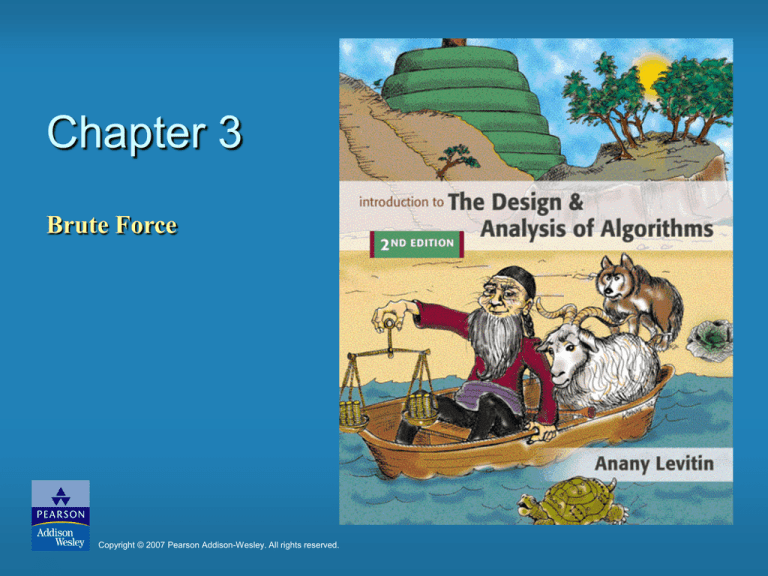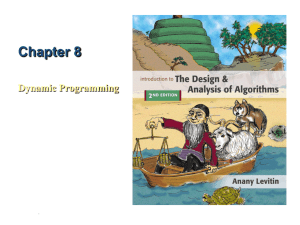
Chapter 3
Brute Force
Copyright © 2007 Pearson Addison-Wesley. All rights reserved.
Brute Force
A straightforward approach, usually based directly on the
problem’s statement and definitions of the concepts involved
Examples:
1.
Computing an (a > 0, n a nonnegative integer)
2.
3.
4.
Computing n!
Multiplying two matrices
Searching for a key of a given value in a list
Copyright © 2007 Pearson Addison-Wesley. All rights reserved.
A. Levitin “Introduction to the Design & Analysis of Algorithms,” 2nd ed., Ch. 3
3-1
Brute-Force Sorting Algorithm
Selection Sort Scan the array to find its smallest element and
swap it with the first element. Then, starting with the second
element, scan the elements to the right of it to find the
smallest among them and swap it with the second elements.
Generally, on pass i (0 i n-2), find the smallest element in
A[i..n-1] and swap it with A[i]:
A[0] . . . A[i-1] | A[i], . . . , A[min], . . ., A[n-1]
in their final positions
Example: 7 3 2 5
Copyright © 2007 Pearson Addison-Wesley. All rights reserved.
A. Levitin “Introduction to the Design & Analysis of Algorithms,” 2nd ed., Ch. 3
3-2
Analysis of Selection Sort
Time efficiency:
Θ(n^2)
Space efficiency:
Θ(1), so in place
Stability:
yes
Copyright © 2007 Pearson Addison-Wesley. All rights reserved.
A. Levitin “Introduction to the Design & Analysis of Algorithms,” 2nd ed., Ch. 3
3-3
Brute-Force String Matching
pattern: a string of m characters to search for
text: a (longer) string of n characters to search in
problem: find a substring in the text that matches the pattern
Brute-force algorithm
Step 1 Align pattern at beginning of text
Step 2 Moving from left to right, compare each character of
pattern to the corresponding character in text until
– all characters are found to match (successful search); or
– a mismatch is detected
Step 3 While pattern is not found and the text is not yet
exhausted, realign pattern one position to the right and
repeat Step 2
Copyright © 2007 Pearson Addison-Wesley. All rights reserved.
A. Levitin “Introduction to the Design & Analysis of Algorithms,” 2nd ed., Ch. 3
3-4
Examples of Brute-Force String Matching
1.
Pattern:
001011
Text: 10010101101001100101111010
2.
Pattern: happy
Text: It is never too late to have a happy
childhood.
Copyright © 2007 Pearson Addison-Wesley. All rights reserved.
A. Levitin “Introduction to the Design & Analysis of Algorithms,” 2nd ed., Ch. 3
3-5
Pseudocode and Efficiency
Time efficiency:
Copyright © 2007 Pearson Addison-Wesley. All rights reserved.
Θ(mn) comparisons (in the worst case)
Why?
A. Levitin “Introduction to the Design & Analysis of Algorithms,” 2nd ed., Ch. 3
3-6
Brute-Force Polynomial Evaluation
Problem: Find the value of polynomial
p(x) = anxn + an-1xn-1 +… + a1x1 + a0
at a point x = x0
Brute-force algorithm
p 0.0
for i n downto 0 do
power 1
for j 1 to i do
//compute xi
power power x
p p + a[i] power
return p
Efficiency:
0in i = Θ(n^2) multiplications
Copyright © 2007 Pearson Addison-Wesley. All rights reserved.
A. Levitin “Introduction to the Design & Analysis of Algorithms,” 2nd ed., Ch. 3
3-7
Polynomial Evaluation: Improvement
We can do better by evaluating from right to left:
Better brute-force algorithm
p a[0]
power 1
for i 1 to n do
power power x
p p + a[i] power
return p
Efficiency:
Θ(n) multiplications
Horner’s Rule is another linear time method.
Copyright © 2007 Pearson Addison-Wesley. All rights reserved.
A. Levitin “Introduction to the Design & Analysis of Algorithms,” 2nd ed., Ch. 3
3-8
Closest-Pair Problem
Find the two closest points in a set of n points (in the twodimensional Cartesian plane).
Brute-force algorithm
Compute the distance between every pair of distinct points
and return the indexes of the points for which the distance
is the smallest.
Copyright © 2007 Pearson Addison-Wesley. All rights reserved.
A. Levitin “Introduction to the Design & Analysis of Algorithms,” 2nd ed., Ch. 3
3-9
Closest-Pair Brute-Force Algorithm (cont.)
Efficiency:
Θ(n^2) multiplications (or sqrt)
How to make it faster?
Copyright © 2007 Pearson Addison-Wesley. All rights reserved.
Using divide-and-conquer!
A. Levitin “Introduction to the Design & Analysis of Algorithms,” 2nd ed., Ch. 3
3-10
Brute-Force Strengths and Weaknesses
Strengths
• wide applicability
• simplicity
• yields reasonable algorithms for some important problems
(e.g., matrix multiplication, sorting, searching, string
matching)
Weaknesses
• rarely yields efficient algorithms
• some brute-force algorithms are unacceptably slow
• not as constructive as some other design techniques
Copyright © 2007 Pearson Addison-Wesley. All rights reserved.
A. Levitin “Introduction to the Design & Analysis of Algorithms,” 2nd ed., Ch. 3
3-11
Exhaustive Search
A brute force solution to a problem involving search for an
element with a special property, usually among combinatorial
objects such as permutations, combinations, or subsets of a
set.
Method:
• generate a list of all potential solutions to the problem in a
systematic manner (see algorithms in Sec. 5.4)
• evaluate potential solutions one by one, disqualifying
infeasible ones and, for an optimization problem, keeping
track of the best one found so far
• when search ends, announce the solution(s) found
Copyright © 2007 Pearson Addison-Wesley. All rights reserved.
A. Levitin “Introduction to the Design & Analysis of Algorithms,” 2nd ed., Ch. 3
3-12
Example 1: Traveling Salesman Problem
Given n cities with known distances between each pair, find
the shortest tour that passes through all the cities exactly
once before returning to the starting city
Alternatively: Find shortest Hamiltonian circuit in a
weighted connected graph
Example:
2
a
b
5
3
8
c
7
4
d
How do we represent a solution (Hamiltonian circuit)?
Copyright © 2007 Pearson Addison-Wesley. All rights reserved.
A. Levitin “Introduction to the Design & Analysis of Algorithms,” 2nd ed., Ch. 3
3-13
TSP by Exhaustive Search
Tour
a→b→c→d→a
a→b→d→c→a
a→c→b→d→a
a→c→d→b→a
a→d→b→c→a
a→d→c→b→a
Efficiency:
Cost
2+3+7+5 = 17
2+4+7+8 = 21
8+3+4+5 = 20
8+7+4+2 = 21
5+4+3+8 = 20
5+7+3+2 = 17
Θ((n-1)!)
Chapter 5 discusses how to generate permutations fast.
Copyright © 2007 Pearson Addison-Wesley. All rights reserved.
A. Levitin “Introduction to the Design & Analysis of Algorithms,” 2nd ed., Ch. 3
3-14
Example 2: Knapsack Problem
Given n items:
• weights: w1 w2 … wn
• values:
v 1 v2 … vn
• a knapsack of capacity W
Find most valuable subset of the items that fit into the knapsack
Example: Knapsack capacity W=16
item weight
value
1
2
$20
2
5
$30
3
10
$50
4
5
$10
Copyright © 2007 Pearson Addison-Wesley. All rights reserved.
A. Levitin “Introduction to the Design & Analysis of Algorithms,” 2nd ed., Ch. 3
3-15
Knapsack Problem by Exhaustive Search
Subset Total weight
Total value
{1}
{2}
{3}
{4}
{1,2}
{1,3}
{1,4}
{2,3}
{2,4}
{3,4}
{1,2,3}
{1,2,4}
{1,3,4}
{2,3,4}
{1,2,3,4}
$20
$30
$50
$10
$50
$70
$30
$80
$40
$60
not feasible
$60
not feasible
not feasible
not feasible
2
5
10
5
7
12
7
15
10
15
17
12
17
20
22
Efficiency: Θ(2^n)
Each subset can be represented by a binary string (bit vector, Ch 5).
Copyright © 2007 Pearson Addison-Wesley. All rights reserved.
A. Levitin “Introduction to the Design & Analysis of Algorithms,” 2nd ed., Ch. 3
3-16
Example 3: The Assignment Problem
There are n people who need to be assigned to n jobs, one
person per job. The cost of assigning person i to job j is C[i,j].
Find an assignment that minimizes the total cost.
Person 0
Person 1
Person 2
Person 3
Job 0 Job 1 Job 2 Job 3
9
2
7
8
6
4
3
7
5
8
1
8
7
6
9
4
Algorithmic Plan: Generate all legitimate assignments, compute
their costs, and select the cheapest one.
How many assignments are there? n!
cycle cover
Pose the problem as one about a cost matrix:
in a graph
Copyright © 2007 Pearson Addison-Wesley. All rights reserved.
A. Levitin “Introduction to the Design & Analysis of Algorithms,” 2nd ed., Ch. 3
3-17
Assignment Problem by Exhaustive Search
9 2 7 8
6 4 3 7
C= 5 8 1 8
7 6 9 4
Assignment (col.#s)
1, 2, 3, 4
1, 2, 4, 3
1, 3, 2, 4
1, 3, 4, 2
1, 4, 2, 3
1, 4, 3, 2
Total Cost
9+4+1+4=18
9+4+8+9=30
9+3+8+4=24
9+3+8+6=26
9+7+8+9=33
9+7+1+6=23
etc.
(For this particular instance, the optimal assignment can be found by
exploiting the specific features of the number given. It is: 2,1,3,4 )
Copyright © 2007 Pearson Addison-Wesley. All rights reserved.
A. Levitin “Introduction to the Design & Analysis of Algorithms,” 2nd ed., Ch. 3
3-18
Final Comments on Exhaustive Search
Exhaustive-search algorithms run in a realistic amount of
time only on very small instances
In some cases, there are much better alternatives!
• Euler circuits
• shortest paths
• minimum spanning tree
• assignment problem
The Hungarian method
runs in O(n^3) time.
In many cases, exhaustive search or its variation is the only
known way to get exact solution
Copyright © 2007 Pearson Addison-Wesley. All rights reserved.
A. Levitin “Introduction to the Design & Analysis of Algorithms,” 2nd ed., Ch. 3
3-19












